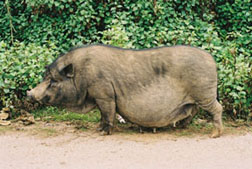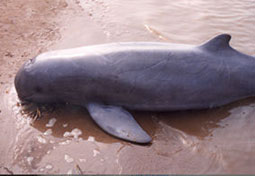Mammals
of floodplain grasslands--
The historical trend for many species of large mammals has been one of
range constriction, population decline, rarity or endangerment, and –
in extreme cases – extinction. Expanses of seasonally inundated grassland
mixed with forest covered floodplains in parts of Asia during the recent
past, provided habitat for a variety of grazing animals (Dudgeon 2000c).
They included Banteng (Bos javanicus), wild Water buffalo (Bubalus
arnee), Asian water deer (Hydropotes inermis), Hog deer (Axis porcinus)
and the now highly endangered Indian rhinoceros (Rhinoceros unicornis).
Sambar deer (Cervus unicolor) make opportunistic use of riverine
habitats and may enter the water to feed. Flushes of vegetation that grow
up after floodwaters recede provide grazing for these and other mammals.
 Specialised
species of marsh deer (e.g., Cervus duvauceli, C. eldi, C. schomburgki,
and Elaphurus davidianus) are – or were – confined to particular
river systems. Due to the high primary productivity of riverine wetlands,
marsh deer attain a larger size than related species confined to dry or
hilly landscapes. Some of them (e.g., Cervus eldi and Elaphurus
davidianus) have hooves adapted to swampy ground, while others (C.
schomburgki) bear elaborately branched and angled antlers that restrict
movement among dense vegetation and – when combined with large body
size – effectively confine marsh deer to open floodplains. Marsh
deer once abounded along the major rivers of India and Thailand, with
ecologically equivalent species in southern and central China. Populations
declined as floodplains were settled and converted to agriculture. Cervus
eldi is now vulnerable and C. schomburgki is already extinct.
The only remaining populations of Elaphurus davidianus in the wild are
made up of reintroduced, formerly captive animals, while the ranges of
other marsh deer (subspecies of C. eldi) are highly restricted.
Specialised
species of marsh deer (e.g., Cervus duvauceli, C. eldi, C. schomburgki,
and Elaphurus davidianus) are – or were – confined to particular
river systems. Due to the high primary productivity of riverine wetlands,
marsh deer attain a larger size than related species confined to dry or
hilly landscapes. Some of them (e.g., Cervus eldi and Elaphurus
davidianus) have hooves adapted to swampy ground, while others (C.
schomburgki) bear elaborately branched and angled antlers that restrict
movement among dense vegetation and – when combined with large body
size – effectively confine marsh deer to open floodplains. Marsh
deer once abounded along the major rivers of India and Thailand, with
ecologically equivalent species in southern and central China. Populations
declined as floodplains were settled and converted to agriculture. Cervus
eldi is now vulnerable and C. schomburgki is already extinct.
The only remaining populations of Elaphurus davidianus in the wild are
made up of reintroduced, formerly captive animals, while the ranges of
other marsh deer (subspecies of C. eldi) are highly restricted.
River
dolphins--
Three of the five species of 'true' river dolphins (which never enter
the sea) are found only in Asia. All are highly endangered, the Yangtze
dolphin (Lipotes vexillifer) probably numbering fewer than 200
individuals. River dolphins are highly specialised for life in turbid
water and, although their vision is poor, they are able to detect prey
by echolocation. The Irrawaddy dolphin (Orcaella brevirostris),
which occurs in the Mekong, is reported to enter the sea, but the Mekong
River population (comprising perhaps 100 individuals) may never do so.
It is thus both isolated and vulnerable (Baird and Mounsouphom 1994; Edwards
2001).